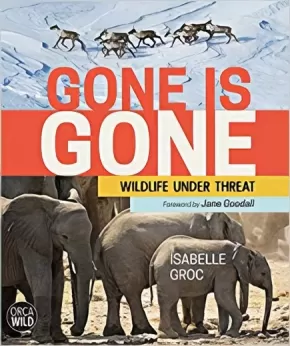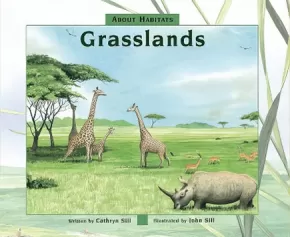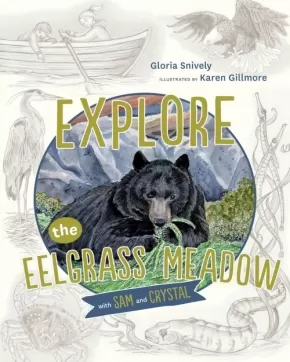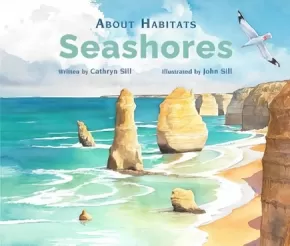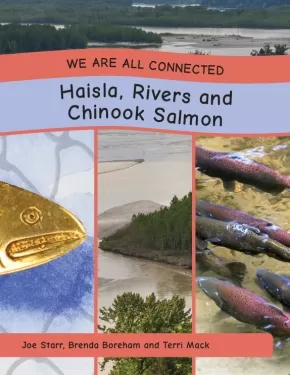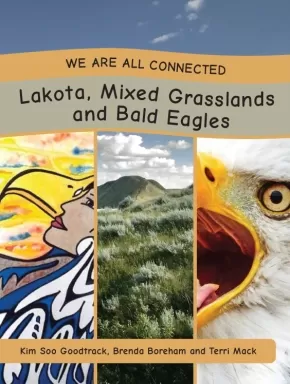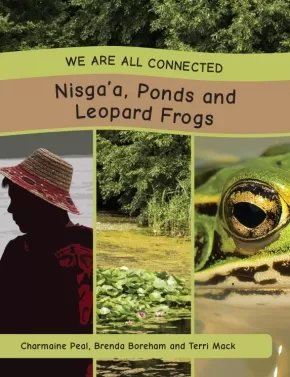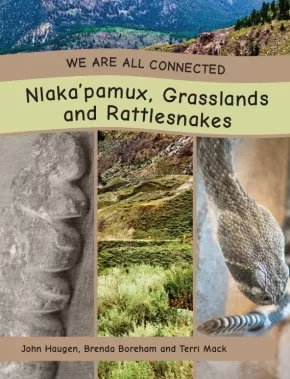
Ecosystem
61
-
75
of
92 Results;
Sort By
Go To
of 7
Gone is Gone: Wildlife Under Threat
$24.95
Format:
Hardcover
ISBN / Barcode: 9781459816855
Synopsis:
Synopsis:
Act for the wild before it's too late!
Gone is Gone looks at why species become endangered, how scientists are learning about endangered wildlife, what people are doing to conserve species and ways young people can help.
The book is richly illustrated with unique photos that Isabelle has taken over many years of observing endangered species in the field alongside the people who work to conserve them. Throughout, the author shares enchanting encounters and personal field stories: watching narwhals socialize in the Canadian Arctic, getting close to a Laysan albatross raising chicks on a remote Hawaiian island, spotting a rhinoceros on safari and even swimming with sea lions in the Galápagos Islands.
Gone is Gone will inform, intrigue and inspire readers to take small steps toward big changes for endangered species around the world.
Reviews
“Animals won’t survive unless people care. I wish this book was available when I started my career in wildlife conservation. It’s got all the information you need to understand the dangers animals face, and how people work to fix those problems so that wild animals can survive. Such people are called conservationists. After reading this excellent book that explains what animals need and what conservationists do, you just might decide to be a conservationist yourself. I hope so. Animals need you.” — Carl Safina, author of Beyond Words: What Animals Think and Feel
“You don’t need to be a child to read this fascinating, informative and personal book about the unique and beautiful wild creatures with whom we share the earth. I, a child no longer, have read it twice, following Isabelle as she traveled far and wide and sharing her joy, her sadness and her growing fears about the survival of so many irreplaceable species and the decimation of their wild homes. I share her belief in the animal as an individual. Everyone should read this book. And I mean everyone. If you have never thought or cared about the survival of wildlife, large and small, I believe you will care after you read this book. I beg you to care—before it is really too late.” — Virginia McKenna, co-founder, Born Free Foundation
Educator Information
Recommended for ages 9 to 12.
This book is part of the Orca Wild series, which explores the lives of the creatures with whom we share the world and asks readers to consider the effects -- both positive and negative -- that humans have on vulnerable animal populations and habitats.
Keywords: saving endangered species, environmental activism, ecosystem awareness, habitat protection, conservation
Additional Information
128 pages | 7.50" x 9.00"
The Grizzly Mother
$23.00
Artists:
Format:
Hardcover
Text Content Territories:
Indigenous Canadian; First Nations; Gitxsan (Gitksan);
ISBN / Barcode: 9781553797760
Synopsis:
Synopsis:
An engaging look at how the animals, people, and seasons within an ecosystem are intertwined.
To the Gitxsan people of Northwestern British Columbia, the grizzly is an integral part of the natural landscape. Together, they share the land and forests that the Skeena River runs through, as well as the sockeye salmon within it. Follow mother bear as she teaches her cubs what they need in order to survive on their own.
The Mothers of Xsan series uses striking illustration and lyrical language to bring the poetry of the Xsan ecosystem to life.
Awards
- Animal Behavior Society's Outstanding Children's Book Award
- 2020 Manuela Dias Design and Illustration Awards, Children's Illustration winner
Educator & Series Information
Recommended for ages 9 - 12.
This is the second book in the Mother of Xsan series, which uses striking illustration and lyrical language to bring the poetry of the Xsan ecosystem to life.
Recommended in the "Canadian Indigenous Books for Schools 2019-2020" resource list as being useful for students in grades 2-5 in these subject areas: English Language Arts, Science, Social Studies.
Additional Information
32 pages | 6.50" x 10.00"
About Habitats: Grasslands
$7.95
Artists:
Format:
Paperback
ISBN / Barcode: 9781682630341
Synopsis:
Synopsis:
This beginner's guide explores the major attributes of the grassland biome and showcases its striking beauty and remarkable diversity using examples from around the globe.
In this addition to the About Habitats series, award-winning author Cathryn Sill uses simple, easy-to-understand language to teach children what grasslands are and what kinds of animals and plants live there. John Sill's detailed, full-color illustrations reflect the diversity of grasslands and the wide variety of the plants and animals that live in grassland habitats.
A glossary and afterword provide further fascinating details about grasslands to inspire readers to learn more.
Awards
- 2012 Outstanding Science Trade Books for Students K-12 winner (US)
- 2012 NSTA Recommends winner (US)
- 2012 Best Children’s Books of the Year winner (US)
Reviews
“Great for classroom sharing.” ― Booklist
“Clear, distinctive text narrates the facts about the habitat, its distinguishing characteristics, and the plant and animal life there …The Sills’ love of science is evident in the text and lovely, full-paged art that adds detail to the information…” ― Simply Science
“There is quite literally something for every level of reader…Absolutely a must have book and series for young scientists as well as those looking to learn more about the world we live in!” ― There’s a Book
Educator Information
With simple text and language, and strong picture support (paintings), this non-fiction narrative teaches children what grasslands are and what kinds of animals and plants live there. A wide variety of the plants and animals that live in grassland habitats are represented.
Text features include: An afterword, facts on the plants and animals featured, glossary of new vocabulary, and websites for further investigation.
Curriculum Connections: Series; Non-fiction narrative; simple sentences; strong picture support paintings; Habitats Grasslands: characteristics; animals; plants; climate; adaptation; Earth and Life Science; Text features: glossary; map; afterword.
Recommended ages: 3-7
Series Information
This book is a part of the About Habitats series, which introduces children to specific habitats and their living and nonliving components.
Additional Information
48 pages | 10.00" x 8.50"
Explore the Eelgrass Meadow with Sam and Crystal
$22.95
Artists:
Format:
Hardcover
Text Content Territories:
Indigenous Canadian;
ISBN / Barcode: 9781772033199
Synopsis:
Synopsis:
With beautiful, scientifically accurate illustrations, this fascinating story teaches children about the many fish, crustaceans, marine mammals, and micro-organisms that live in and feed off the eelgrass meadows of the north Pacific coastal region.
Sam and Crystal’s coastal adventure continues as brother and sister dive deeper—literally—into the marine habitats of Eagle Cove, home of Aunt Kate and Uncle Charlie. In their third adventure, the kids learn about one of the most ecologically important ecosystems on the west coast: the eelgrass meadow. This rich habitat provides food and shelter to countless marine critters—from tiny micro-organisms to juvenile fish, and is the basis of a gigantic food web that supports herring, salmon, black bears, humpback whales and many other species. Ada, an Indigenous woman from nearby Salmon Bay Village, tells the children about her people’s knowledge of land and sea, complementing Aunt Kate’s Western scientific teachings and reinforcing the importance of respecting nature. Combining an entertaining story with gorgeous imagery and the author’s scientific background and extensive work with Indigenous Elders and educators, Explore the Eelgrass Meadow with Sam and Crystal brings the coastline to life for children ages eight and up.
Reviews
"Dr. Snively captures the wonder and excitement of the rich eelgrass meadow and associated ocean ecosystems. Seen through the eyes of two delightful, curious children, the biological wonders of this habitat are interpreted by a marine biologist, a fisherman uncle, a First Nations Elder, and even a small, wise, and perceptive fish. Beautifully illustrated by Karen Gillmore, scientifically accurate, and fun to read, this story of the ocean coast and all its relationships will captivate children and adults alike." - Dr. Nancy Turner, ethnobotanist
"A special story that will whet young people's curiosity about the very special ecosystem of native eelgrass in the Pacific Northwest." - Nikki Wright, Executive Director, SeaChange Marine Conservation Society
"Gloria Snively and Karen Gillmore do it again, bringing fascinating, detailed information about eelgrass meadows and the mysteries and value of our oceans to youth of all ages. Respect, equality, sustainable use, and conservation are all wrapped up in the words and pictures of the working west coast." - Dr. Joachim Carolsfeld, World Fisheries Trust
Educator & Series Information
Recommended for ages 8-11.
This book is part of the Explore with Sam and Crystal series.
A brother and sister learn about the importance of the eelgrass meadow, a fascinating and complex marine ecosystem that sustains a variety of life on the North Pacific coast.
This book explores themes of marine biology, biodiversity, animal behavior and the interconnectedness of animal species with their habitats. It examines ethical issues related to environmental protection, endangered species and people’s respect for nature.
Gloria Snively was compelled to write this series because of the serious degradation of our coastal ecosystems. As an educator and curriculum developer, she feels we need to do a better job of educating youth about basic marine ecology.
Snively is a founding member of the Northwest Association of Marine Educators (NAME).
Additional Information
64 pages | 8.00" x 10.00"
Forest Biomes
$9.95
Format:
Paperback
ISBN / Barcode: 9780778740377
Synopsis:
Synopsis:
This gorgeous book gives readers core information about forests in the taiga, tropical and temperate rainforests, and deciduous forest biomes. Find out where each kind is found, how animals and plants have adapted to life among the trees, who lives in these forests, and how humans impact life there.
Educator Information
Recommended for ages 8 to 11.
Reading Level: Gr. 4
Interest Level: Gr. 3-6
Guided Reading Level: T
Glossary and index included.
Additional Information
32 pages | 8.50" x 10.75"
About Habitats: Seashores
$11.99
Artists:
Format:
Paperback
ISBN / Barcode: 9781682634028
Synopsis:
Synopsis:
Studying nature? Going to the beach? Dig into this classroom favorite and beginner's guide to seashores from the creators of the award-winning About Habitats series.
In this accessible introduction to a familiar locale, author and educator Cathryn Sill uses simple, easy-to-understand language to teach children about seashores and their diversity, the types of animals and plants that live there, and why they're important.
The stunning paintings by noted wildlife illustrator John Sill depict the wide variety of seashore topography.
A glossary and afterword provide more details about each seashore featured in the book. Perfect for early childhood and elementary units on nature, environment, and ecosystems.
Awards
- Outstanding Science Trade Books for Students K-12 —National Science Teachers Association, Children’s Book Council, 2018 (US)
Reviews
“Another excellent edition… The beautifully designed layout and succinct text combine with the back matter to offer very accessible nonfiction reading for the very young as well as early grade students.” —Kirkus Reviews
“With reliable information and attractive illustrations, this volume is a useful addition to a series celebrating its tenth year.” —Booklist
“Useful for introductory units on marine and earth science.” —School Library Journal
Educator & Series Information
With simple text and language, and strong picture support (paintings), this non-fiction narrative teaches children what seashores are and what kinds of animals and plants live there.
Recommended ages: 3-7
This book is a part of the About Habitats series, which introduces children to specific habitats and their living and nonliving components.
Additional Information
48 pages | 10.00" x 8.50" | Paperback
The Sockeye Mother
$23.00
Artists:
Format:
Hardcover
Text Content Territories:
Indigenous Canadian; First Nations; Gitxsan (Gitksan);
ISBN / Barcode: 9781553797395
Synopsis:
Synopsis:
To the Gitxsan people of Northwestern British Columbia, the sockeye salmon is more than just a source of food. Over its life cycle, it nourishes the very land and forests that the Skeena River runs through and where the Gitxsan make their home. The Sockeye Mother explores how the animals, water, soil, and seasons are all intertwined.
1 SMALL FRY
There’s a strong undertow today. The turbulent waters caress the backs of the little semelparous life forms emerging from their gravel nests. A small free-swimming fry bears witness to the currents of spring, after spending weeks developing and using up its nutritious yolk sack. It’s one of few remaining fry leaving its long winter’s home to seek out nursing waters.
This is the time of Wihlaxs (the black bear’s walking moon), which is early spring to the Gitxsan peoples of the Pacific Northwest Interior. Change is in the air, the days grow longer, and renewal is the life force that guides the world around the little fry’s waterways. Flora cells are starting to stir, preparing to bud and bring green to the landscape. Stores of food for the people along Xsan (river of mists) is running low, but preparations for the new seasons of fishing and gathering have begun. New snow falls to take away the old snow, which the Gitxsan call dalugwa.
Miso’o, or sockeye, are one of many species of salmon that call Xsan home. Although all species are valued, the Gitxsan prefer the flavour and number of Sockeye that return to their spawning grounds every year. The cultures along Xsan, otherwise known as the Skeena River, flourished and shaped their existence around the life cycles of this keystone species. Little does this small sockeye fry know that its life cycle not only nourishes the people and other beings along the watersheds, it is the whole reason the forests and landscapes exist.
2 TIME TO GROW
After a couple of years of “schooling” in the deeper parts of the nursing lake, this sockeye has become a smolt. Its little silvery body begins taking the shape of its blue-backed future self. The smolt is outgrowing the lake, and this signals Lasa ya’a (the spring salmon’s returning moon), so the little sockeye begins its treacherous journey down the Skeena.
As the spring salmons return, the sockeye smolts depart to relieve their urge for saliferous waters. April carries summer innuendos, as warm winds flow through nearly blooming flowers. The scent of pines and cedar waft across moist pillowy moss. The nets and rods of the Gitxsan people scour Xsan in hopes of taking part in the return of ya’a, the spring salmon. Ceremony is held and feasts occur to welcome the runs of salmon who come to replenish the land. It’s not only a time to give thanks, but also a time to send prayer that the salmon will always return, that they will provide nourishment for all that is living within its realm.
The young sockeye has so far avoided predation, dodged the unnaturally changing landscape denuding from the clear-cutting of man, and escaped the hungry hands of ’watxs, the otter. The smolt and her school have made their journey to the Pacific, and north to the ocean waters, where they will continue to feed and grow.
3 A REPLENISHING DEATH
For two years the sockeye mother has been feeding in the ocean waters, while avoiding sharks and killer whales. Through instinct, smell and much that is still not understood, the sockeye mother swims against the powerful currents of Xsan to return to the exact place in the rivers where she was spawned.
It’s now Lasa lik’i’nxsw (the grizzly bear’s moon). August is the time when all the Gitxsan people and grizzly bears pluck hundreds of thousands of sockeye from the Skeena. Many predators such as the grizzly discard most of the carcass. They carry their catch sometimes hundreds of metres into the forest, only to eat the fatty bellies and eggs. The decaying bodies of the salmon leaves nitrogen that nourishes the soil.
Battered and beaten by the journey, she is literally decaying due to lack of food and constant hard work. She finds a male partner who’s dug a nest to her liking. She lays her eggs. She can now die a replenishing death. The dying salmon bodies become fertilizer for all the flora that shape the great lands. Without the sockeye mother, the Gitxsan as they are, would simply not exist.
Awards
- The Science Writers and Communicators of Canada Award, Youth Category.
- McNally Robinson Book for Young People Award
Educator & Series Information
Recommended for Grades 4-7 for theses subject areas: Science, Social Studies.
This book is part of the Mother of Xsan series, which uses striking illustration and lyrical language to bring the poetry of the Xsan ecosystem to life.
Additional Information
| 32 pages | 6.50" x 10.00" |
We Are All Connected: Coast Salish, Coastal Rainforests and Cougars
 $21.95
$21.95

Format:
Paperback
Text Content Territories:
Indigenous Canadian; First Nations; Salish; Coast Salish;
ISBN / Barcode: 9781771742504
Synopsis:
Synopsis:
“We Are All Connected” is a series that explores how we all live together in a shared balance upon Mother Earth. Each book explores a specific ecosystem with a focus on one animal and its adaptations for survival within that ecosystem. Indigenous interviewees, each living within the same area, have responded to strategic questions as to how their community interacts with the land, their traditional territory. Explore each text with a sense of inquiry in mind.
8 We Are All Connected Titles Coast Salish, Coastal Rainforests and Cougars Haisla, Rivers and Chinook Salmon Inuit, Tundra and Ravens Lakota, Mixed Grasslands and Bald Eagles Métis, Wetlands and Mallards Nisga'a, Ponds and Leopard Frogs Nlaka'pamux, Grasslands and Rattlesnakes Sto:lo, Riparian Forests and Black Bears Each title covers the following curricular areas. Traditional storytelling and artwork begin each title from the focus Indigenous territory. Science: Biodiversity, classification, life cycles, food chains, food webs and connections between living and non-living things are just some of the science concepts included in each book. Social Studies: Contemporary and historical Indigenous cultural knowledge flows throughout each book. Local land forms, gatherings, harvesting practices and government are some of the social studies concepts included in each book.
2 Foundation Titles The two foundational books provide deeper understanding of the content of the “We Are All Connected” titles. We Are All Connected: The Earth, Our Home- explores biomes, ecosystems and biodiversity. We Are All Connected: The Earth, We Share- explores the interconnectedness between living and non-living things.
Authenticity Note: This work contains some Indigenous artwork and photographs from Celestine Aleck.
Additional Information
32 pages | 8.50" x 11.00" | IBSN: 9781771742504
We Are All Connected: Haisla, Rivers and Chinook Salmon
 $21.95
$21.95

Format:
Paperback
Text Content Territories:
Indigenous Canadian; First Nations; Haisla (Kitamaat);
ISBN / Barcode: 9781771742467
Synopsis:
Synopsis:
“We Are All Connected” is a series that explores how we all live together in a shared balance upon Mother Earth. Each book explores a specific ecosystem with a focus on one animal and its adaptations for survival within that ecosystem. Indigenous interviewees, each living within the same area, have responded to strategic questions as to how their community interacts with the land, their traditional territory. Explore each text with a sense of inquiry in mind.
8 We Are All Connected Titles Coast Salish, Coastal Rainforests and Cougars Haisla, Rivers and Chinook Salmon Inuit, Tundra and Ravens Lakota, Mixed Grasslands and Bald Eagles Métis, Wetlands and Mallards Nisga'a, Ponds and Leopard Frogs Nlaka'pamux, Grasslands and Rattlesnakes Sto:lo, Riparian Forests and Black Bears Each title covers the following curricular areas. Traditional storytelling and artwork begin each title from the focus Indigenous territory. Science: Biodiversity, classification, life cycles, food chains, food webs and connections between living and non-living things are just some of the science concepts included in each book. Social Studies: Contemporary and historical Indigenous cultural knowledge flows throughout each book. Local land forms, gatherings, harvesting practices and government are some of the social studies concepts included in each book.
2 Foundation Titles The two foundational books provide deeper understanding of the content of the “We Are All Connected” titles. We Are All Connected: The Earth, Our Home- explores biomes, ecosystems and biodiversity. We Are All Connected: The Earth, We Share- explores the interconnectedness between living and non-living things.
Authenticity Note: There is some Indigenous art in this book, such as a pendant carved by a Haida artist.
Additional Information
32 pages | 8.50" x 11.00" | ISBN: 9781771742467
We Are All Connected: Inuit, Tundra and Ravens
 $21.95
$21.95

Format:
Paperback
Text Content Territories:
Indigenous Canadian; Inuit;
ISBN / Barcode: 9781771742481
Synopsis:
Synopsis:
“We Are All Connected” is a series that explores how we all live together in a shared balance upon Mother Earth. Each book explores a specific ecosystem with a focus on one animal and its adaptations for survival within that ecosystem. Indigenous interviewees, each living within the same area, have responded to strategic questions as to how their community interacts with the land, their traditional territory. Explore each text with a sense of inquiry in mind.
8 We Are All Connected Titles Coast Salish, Coastal Rainforests and Cougars Haisla, Rivers and Chinook Salmon Inuit, Tundra and Ravens Lakota, Mixed Grasslands and Bald Eagles Métis, Wetlands and Mallards Nisga'a, Ponds and Leopard Frogs Nlaka'pamux, Grasslands and Rattlesnakes Sto:lo, Riparian Forests and Black Bears Each title covers the following curricular areas. Traditional storytelling and artwork begin each title from the focus Indigenous territory. Science: Biodiversity, classification, life cycles, food chains, food webs and connections between living and non-living things are just some of the science concepts included in each book. Social Studies: Contemporary and historical Indigenous cultural knowledge flows throughout each book. Local land forms, gatherings, harvesting practices and government are some of the social studies concepts included in each book.
2 Foundation Titles The two foundational books provide deeper understanding of the content of the “We Are All Connected” titles. We Are All Connected: The Earth, Our Home- explores biomes, ecosystems and biodiversity. We Are All Connected: The Earth, We Share- explores the interconnectedness between living and non-living things.
Authenticity Note: This title includes some Indigenous artwork and photographs, such as artwork from Tooma Laisa and Terri Mack.
Additional Information
32 Pages | 8.5" x 11" | ISBN: 9781771742481
We Are All Connected: Lakota, Mixed Grasslands and Bald Eagles
 $21.95
$21.95

Format:
Paperback
Text Content Territories:
Indigenous Canadian; First Nations; Sioux; Lakota;
ISBN / Barcode: 9781771742474
Synopsis:
Synopsis:
“We Are All Connected” is a series that explores how we all live together in a shared balance upon Mother Earth. Each book explores a specific ecosystem with a focus on one animal and its adaptations for survival within that ecosystem. Indigenous interviewees, each living within the same area, have responded to strategic questions as to how their community interacts with the land, their traditional territory. Explore each text with a sense of inquiry in mind.
8 We Are All Connected Titles Coast Salish, Coastal Rainforests and Cougars Haisla, Rivers and Chinook Salmon Inuit, Tundra and Ravens Lakota, Mixed Grasslands and Bald Eagles Métis, Wetlands and Mallards Nisga'a, Ponds and Leopard Frogs Nlaka'pamux, Grasslands and Rattlesnakes Sto:lo, Riparian Forests and Black Bears Each title covers the following curricular areas. Traditional storytelling and artwork begin each title from the focus Indigenous territory. Science: Biodiversity, classification, life cycles, food chains, food webs and connections between living and non-living things are just some of the science concepts included in each book. Social Studies: Contemporary and historical Indigenous cultural knowledge flows throughout each book. Local land forms, gatherings, harvesting practices and government are some of the social studies concepts included in each book.
2 Foundation Titles The two foundational books provide deeper understanding of the content of the “We Are All Connected” titles. We Are All Connected: The Earth, Our Home- explores biomes, ecosystems and biodiversity. We Are All Connected: The Earth, We Share- explores the interconnectedness between living and non-living things.
Authenticity Note: This work contains some Indigenous artwork and photographs throughout, such as artwork from Kim Soo Goodtrack.
Additional Information
32 pages | 8.50" x 11.00" | ISBN" 9781771742474
We Are All Connected: Métis, Wetlands and Mallards
 $21.95
$21.95

Format:
Paperback
Text Content Territories:
Indigenous Canadian; Métis;
ISBN / Barcode: 9781771742511
Synopsis:
Synopsis:
“We Are All Connected” is a series that explores how we all live together in a shared balance upon Mother Earth. Each book explores a specific ecosystem with a focus on one animal and its adaptations for survival within that ecosystem. Indigenous interviewees, each living within the same area, have responded to strategic questions as to how their community interacts with the land, their traditional territory. Explore each text with a sense of inquiry in mind.
8 We Are All Connected Titles Coast Salish, Coastal Rainforests and Cougars Haisla, Rivers and Chinook Salmon Inuit, Tundra and Ravens Lakota, Mixed Grasslands and Bald Eagles Métis, Wetlands and Mallards Nisga'a, Ponds and Leopard Frogs Nlaka'pamux, Grasslands and Rattlesnakes Sto:lo, Riparian Forests and Black Bears Each title covers the following curricular areas. Traditional storytelling and artwork begin each title from the focus Indigenous territory. Science: Biodiversity, classification, life cycles, food chains, food webs and connections between living and non-living things are just some of the science concepts included in each book. Social Studies: Contemporary and historical Indigenous cultural knowledge flows throughout each book. Local land forms, gatherings, harvesting practices and government are some of the social studies concepts included in each book.
2 Foundation Titles The two foundational books provide deeper understanding of the content of the “We Are All Connected” titles. We Are All Connected: The Earth, Our Home- explores biomes, ecosystems and biodiversity. We Are All Connected: The Earth, We Share- explores the interconnectedness between living and non-living things.
Authenticity Note: This book contains some Indigenous artwork and photos throughout, such as artwork from Leah Marie Dorion.
Additional Information
32 pages | 8.50" x 11.00" | ISBN: 9781771742511
We Are All Connected: Nisga'a, Ponds and Leopard Frogs
 $21.95
$21.95

Format:
Paperback
Text Content Territories:
Indigenous Canadian; First Nations; Nisga'a;
ISBN / Barcode: 9781771742498
Synopsis:
Synopsis:
“We Are All Connected” is a series that explores how we all live together in a shared balance upon Mother Earth. Each book explores a specific ecosystem with a focus on one animal and its adaptations for survival within that ecosystem. Indigenous interviewees, each living within the same area, have responded to strategic questions as to how their community interacts with the land, their traditional territory. Explore each text with a sense of inquiry in mind.
8 We Are All Connected Titles Coast Salish, Coastal Rainforests and Cougars Haisla, Rivers and Chinook Salmon Inuit, Tundra and Ravens Lakota, Mixed Grasslands and Bald Eagles Métis, Wetlands and Mallards Nisga'a, Ponds and Leopard Frogs Nlaka'pamux, Grasslands and Rattlesnakes Sto:lo, Riparian Forests and Black Bears Each title covers the following curricular areas. Traditional storytelling and artwork begin each title from the focus Indigenous territory. Science: Biodiversity, classification, life cycles, food chains, food webs and connections between living and non-living things are just some of the science concepts included in each book. Social Studies: Contemporary and historical Indigenous cultural knowledge flows throughout each book. Local land forms, gatherings, harvesting practices and government are some of the social studies concepts included in each book.
2 Foundation Titles The two foundational books provide deeper understanding of the content of the “We Are All Connected” titles. We Are All Connected: The Earth, Our Home- explores biomes, ecosystems and biodiversity. We Are All Connected: The Earth, We Share- explores the interconnectedness between living and non-living things.
Authenticity Note: This work contains some Indigenous artwork and photographs throughout, such as artwork and photos from Charmaine Peal.
Additional Information
32 pages | 8.50" x 11.00" | ISBN: 9781771742498
We Are All Connected: Nlaka'pamux, Dry Grasslands and Rattlesnakes
 $21.95
$21.95

Format:
Paperback
Text Content Territories:
Indigenous Canadian; First Nations; Salish; Interior Salish; Nlaka'pamux (Thompson);
ISBN / Barcode: 9781771742528
Synopsis:
Synopsis:
“We Are All Connected” is a series that explores how we all live together in a shared balance upon Mother Earth. Each book explores a specific ecosystem with a focus on one animal and its adaptations for survival within that ecosystem. Indigenous interviewees, each living within the same area, have responded to strategic questions as to how their community interacts with the land, their traditional territory. Explore each text with a sense of inquiry in mind.
8 We Are All Connected Titles Coast Salish, Coastal Rainforests and Cougars Haisla, Rivers and Chinook Salmon Inuit, Tundra and Ravens Lakota, Mixed Grasslands and Bald Eagles Métis, Wetlands and Mallards Nisga'a, Ponds and Leopard Frogs Nlaka'pamux, Grasslands and Rattlesnakes Sto:lo, Riparian Forests and Black Bears Each title covers the following curricular areas. Traditional storytelling and artwork begin each title from the focus Indigenous territory. Science: Biodiversity, classification, life cycles, food chains, food webs and connections between living and non-living things are just some of the science concepts included in each book. Social Studies: Contemporary and historical Indigenous cultural knowledge flows throughout each book. Local land forms, gatherings, harvesting practices and government are some of the social studies concepts included in each book.
2 Foundation Titles The two foundational books provide deeper understanding of the content of the “We Are All Connected” titles. We Are All Connected: The Earth, Our Home- explores biomes, ecosystems and biodiversity. We Are All Connected: The Earth, We Share- explores the interconnectedness between living and non-living things.
Authenticity Note: This title includes some authentic Indigenous photographs.
Additional Information
32 pages | 8.50" x 11.00" | ISBN: 9781771742528
We Are All Connected: Sto:lo, Riparian Forests and Black Bears
 $21.95
$21.95

Format:
Paperback
Text Content Territories:
Indigenous Canadian; First Nations; Salish; Coast Salish; Sto:lo;
ISBN / Barcode: 9781771742450
Synopsis:
Synopsis:
“We Are All Connected” is a series that explores how we all live together in a shared balance upon Mother Earth. Each book explores a specific ecosystem with a focus on one animal and its adaptations for survival within that ecosystem. Indigenous interviewees, each living within the same area, have responded to strategic questions as to how their community interacts with the land, their traditional territory. Explore each text with a sense of inquiry in mind.
8 We Are All Connected Titles Coast Salish, Coastal Rainforests and Cougars Haisla, Rivers and Chinook Salmon Inuit, Tundra and Ravens Lakota, Mixed Grasslands and Bald Eagles Métis, Wetlands and Mallards Nisga'a, Ponds and Leopard Frogs Nlaka'pamux, Grasslands and Rattlesnakes Sto:lo, Riparian Forests and Black Bears Each title covers the following curricular areas. Traditional storytelling and artwork begin each title from the focus Indigenous territory. Science: Biodiversity, classification, life cycles, food chains, food webs and connections between living and non-living things are just some of the science concepts included in each book. Social Studies: Contemporary and historical Indigenous cultural knowledge flows throughout each book. Local land forms, gatherings, harvesting practices and government are some of the social studies concepts included in each book.
2 Foundation Titles The two foundational books provide deeper understanding of the content of the “We Are All Connected” titles. We Are All Connected: The Earth, Our Home- explores biomes, ecosystems and biodiversity. We Are All Connected: The Earth, We Share- explores the interconnectedness between living and non-living things.
Authenticity Note: This book contains some Indigenous artwork and photographs, such as photos from Rod Peters and artwork from Celestine Aleck.
Additional Information
32 pages | 8.50" x 11.00" | ISBN: 9781771742450
Sort By
Go To
of 7

